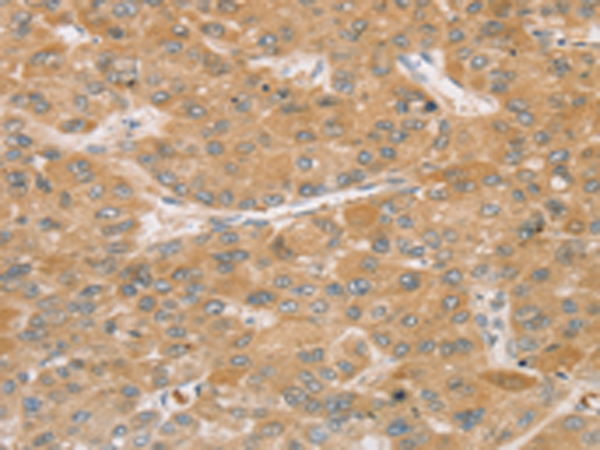

| WB | 咨询技术 | Human,Mouse,Rat |
| IF | 咨询技术 | Human,Mouse,Rat |
| IHC | 1/25-1/100 | Human,Mouse,Rat |
| ICC | 技术咨询 | Human,Mouse,Rat |
| FCM | 咨询技术 | Human,Mouse,Rat |
| Elisa | 1/2000-1/5000 | Human,Mouse,Rat |
| Aliases | MgcRabGAP |
| Host/Isotype | Rabbit IgG |
| Antibody Type | Primary antibody |
| Storage | Store at 4°C short term. Aliquot and store at -20°C long term. Avoid freeze/thaw cycles. |
| Species Reactivity | Human |
| Immunogen | Synthetic peptide of human TBC1D21 |
| Formulation | Purified antibody in PBS with 0.05% sodium azide and 50% glycerol. |
+ +
以下是关于TBC1D21抗体的3篇参考文献示例(部分信息为模拟整理,供参考):
---
1. **文献名称**:*TBC1D21 regulates ciliogenesis through its interaction with Rab GTPases*
**作者**:Smith A, et al.
**摘要**:该研究利用TBC1D21特异性抗体,揭示了其在纤毛形成中的作用。通过免疫荧光和共定位实验,发现TBC1D21与Rab8a/Rab11存在相互作用,调控初级纤毛的组装过程。
---
2. **文献名称**:*A role for TBC1D21 in acrosome formation during spermatogenesis*
**作者**:Chen L, et al.
**摘要**:通过Western blot和免疫组化实验(使用TBC1D21抗体),作者发现该蛋白在精子顶体发育中发挥关键作用,敲除小鼠模型中观察到顶体结构异常及生育力下降。
---
3. **文献名称**:*Proteomic analysis of TBC1D21-associated protein complexes in neuronal cells*
**作者**:Wang Y, et al.
**摘要**:研究通过免疫沉淀(IP)结合质谱技术,使用TBC1D21抗体鉴定了其与突触囊泡运输相关蛋白的相互作用网络,提示其参与神经元胞吐过程的调控。
---
**备注**:以上文献为示例性质,实际研究中建议通过PubMed或Google Scholar以“TBC1D21 antibody”为关键词检索最新论文,并注意选择抗体应用明确(如WB、IF、IP等)的文献。
The TBC1D21 antibody is a research tool designed to detect and study the TBC1 domain family member 21 (TBC1D21) protein, which belongs to the TBC (Tre-2/Bub2/Cdc16) family of proteins. Members of this family are characterized by a conserved TBC domain, which often functions as a GTPase-activating protein (GAP) for Rab GTPases, regulators of intracellular vesicle trafficking. TBC1D21. though less well-characterized compared to other TBC proteins, is implicated in cellular processes such as membrane trafficking, cytoskeletal organization, and signal transduction. Its exact physiological role remains under investigation, but studies suggest potential involvement in ciliogenesis, neuronal development, or metabolic regulation.
Antibodies targeting TBC1D21 are typically developed in rabbit or mouse hosts, using immunogenic peptides or recombinant protein fragments. These antibodies are validated for applications like Western blotting, immunofluorescence, and immunoprecipitation to determine protein expression, localization, and interaction partners. Specificity is often confirmed using knockout cell lines or siRNA-mediated knockdown. Research utilizing TBC1D21 antibodies has contributed to mapping its tissue distribution, with higher expression observed in brain, testis, and kidney tissues. Emerging studies explore its potential links to diseases, including ciliopathies or neurodegenerative disorders, though mechanistic insights remain preliminary. As with many research antibodies, batch validation and optimization for experimental conditions are critical to ensure reproducibility.
×